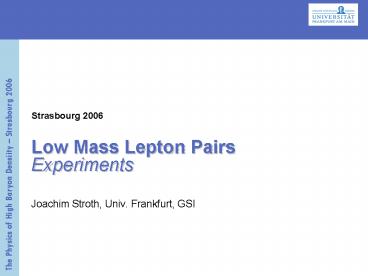Strasbourg 2006 - PowerPoint PPT Presentation
1 / 27
Title:
Strasbourg 2006
Description:
The Physics of High Baryon Densiity Strasbourg 2006. VM modification in reactions on nuclei ... The Physics of High Baryon Densiity Strasbourg 2006. C C ... – PowerPoint PPT presentation
Number of Views:25
Avg rating:3.0/5.0
Title: Strasbourg 2006
1
Strasbourg 2006
- Low Mass Lepton Pairs Experiments
- Joachim Stroth, Univ. Frankfurt, GSI
2
Motivation
- The dilepton signal contains contributions from
throughout the collision, .. - ... i.e. also direct radiation from the early
phase. - It probes the electromagnetic structure of
dense/hot nuclear(or partonic) matter.
3
Motivation (Chiral Symmetry Restoration)
- Substantial depletion of the condensates already
in collisions at moderate beam energy.
2-quark condensate
4-quark condensate
4
Experimental strategy
- AA collisions
- Radiation from the dense/hot phase
- Identify/subtract combinatorial background
- Identify/subtract contributions from late hadron
decays - p,p,g on A
- Modification of (w,f) spectral functions
- High resolution
- elementary reactions
- gain knowledge on production mechanisms
5
VM modification in reactions on nuclei
- KEK
- proton induced reactions.
- r drops10 but no broadening
- TAPS/ELSA
- Photoproduction
- w is broadened (G 90 MeV) and dropping
6
Overview
Alice
LHC
IT HPID
RHIC
SPS
CERES
TPC
SIS300
SIS 100AGS
upgrade
SIS18 Bevalac
time (technological advance)
7
The HADES experiment _at_ GSI
- f symmetry
- hadron blind RICH
- 2 mass resolution (10 without outer tracking)
8
CC 2AGeV ee- invariant mass spectrum
signal lt 140 MeV/c2 20971 counts signal gt 140
MeV/c2 1937 counts
100 M electron trigger e e- pairs measured
over 5 orders of magnitude
9
HADES data
- Electron pair yield observed in acceptance
- Corrected for reconstruction efficiency
- PLUTO (thermal) event generator yields from TAPS
measurement and using mt scaling.
10
CC 2AGeV Comparison to transport
Conventional sources under control
Vacuum spectral functions Differences in the
description of D's and VM's
11
CC 1AGeV HADES data (preliminary)
- Electron pair yield observed in acceptance
- Corrected for reconstruction efficiency
- Substantial yield above the h contribution
preliminary
12
The DLS spectrometer _at_ LBL
HADES
DLS
mid-rapidity
13
DLS and RQMD (Tübingen Group)
The puzzle remains
C. Fuchs et al.
14
Comparison with the DLS results
- generated events processed by the full
- HADES analysis including
- detector (in)efficiency
- reconstruction (in)efficiency
15
The CERES Spectrometer _at_ CERN
CERES
- f symmetry
- dE/dX in silicon drift for background rejection
- 3.8 mass resolution (TPC upgrade)
16
CERES data
CERES
No substantial 'hole" between w and f pole mass
J. Stachel, ISHIP 2006 and nucl-ex/0511010
17
The NA60 spectrometer _at_ CERN
- High resolution tracking by means of silicon
(pixel) detectors. Mass resolution 2.3 (f) - Challenge
- Track matching through absorber
- Match in configuration and momentum space
18
NA60 acceptance
Gain in statistics over CERES gt 1000
S. Damjanovic, Hot Quarks 2006
19
NA60 systematic uncertainties
S. Damjanovic, Hot Quarks 2006
20
NA60 centrality dependence
Can this help to reduce uncertainties in the
fireball evolution (surface effects)
S. Damjanovic, Asilomar 2006
21
NA60 pT Spectra
different mass bins
comparison to theory
S. Damjanovic, Asilomar 2006
22
LMLP in PHENIX _at_ RHIC
S/B between 10-2 10-3
S/B will get much better once the HPID is
operational
A. Toja, Hot Quarks 2006
23
From HADES to CBM _at_ FAIR
CBM 8 45 AGeV
HADES 2 8 AGeV
24
Dielectron reconstruction in CBM
- Fast, high-precision tracking using silicon
sensors. - No electron identification before tracking
25
Background rejection performance
- AuAu 25 AGeV, central collisions
- Signal mixed into UrQMD events
T. Galatyuk, CBM coll. meeting 2005
26
The muon option in CBM
J/??µµ-
s/b 100
C/Fe absorbers detector layers
- Simulation AuAu 25 AGeV
- Excellent signal to background ratio in high mass
region. - Low efficiency for small invariant masses and/or
low pT (enhancement region). - Challenging muon detector (high particle
densities)
?
?
f
A. Kiseleva, Y.Vassiliev
27
Challenges for next generation experiments
- Improve characterization
- Double differential (e.g. inv. mass, pt)
- Centrality dependence
- Reduce uncertainties
- Statistical errors
- Fast detectors and DAQ
- Develop a trigger (not always easy, excellent
detectors needed) - Systematical errors
- Control combinatorial background (good background
rejection) - Fully understand efficiencies of detectors, track
reconstruction, rejection cuts - Good to know before design freeze-out
- What precision is really needed to distinguish
between scenarios? - Can one control uncertainties due to missing
information about the fireball evolution?































